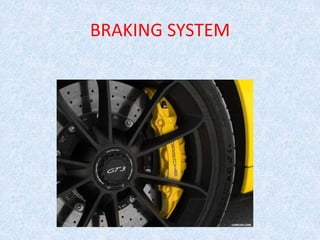Braking system ppt
- 2. BRAKE The device used to stop any vehicle by applying frictional force. One of the most important control components of vehicle. They are required to stop vehicle within smallest possible distance. This is done by converting kinetic of vehicle into heat energy and dissipated it into atmosphere.
- 3. WORKING OF BRAKE We step on brake pedal. The plunger is pushed into the master cylinder. Hydraulic fluid is forced through a series of tubes to the braking unit. Brake shoe in Drum brake and calipers in Disk brake are pushed against drum and piston , causing wheel to stop.
- 4. DIFFERENT COMPONENTS OF BRAKING SYSTEM 1. BRAKE FLUID It is a special oil with some specific properties. It can withstand cold temperature without thickening as well as very high temperature without boiling. The current standard is DOT-3, which has a boiling point of 460F. 2. BRAKE LINES These are the series of steel tubes and rubber hoses though which brake fluid travels. Rubber hoses are used only in places that requires flexibility , such as front wheels. Its dangerous to use brass fittings or tubing to repair brake lines.
- 5. 3. MASTER CYLINDER It is located in the engine compartment on the firewall. It is actually two separate master cylinders in one housing, so if one side fails ,we will still be able to stop. It consists of fluid which compensates for any change in fluid volume in the pipeline. when sufficient pressure has build up, the inner rubber cup is deflected, forcing the fluid in lines, thereby applying brakes.
- 6. 4. COMBINATION VALVE It is combination of PROPORTIONING VALVE AND PRESSURE DIFFERENTIAL VALVE 1. PROPORTIONING VALVE: These are mounted between the master cylinder and rear wheels, which adjusts the pressure between the front and rear brakes. 2. PRESSURE DIFFERENTIAL VALVE: Mounted just below the master cylinder , it measures the pressure from the two section of master cylinder and detects a malfunctions if any.
- 7. CLASSIFICATION OF BRAKES ON DIFFERENT BASIS : 2. CONSTRUCTIONAL BASIS Drum brake Disk brake 1. METHOD OF ACTUATION Mechanical brake Hydraulic brake Electric brake Vacuum brake Air brake
- 8. 1. MECHANICAL BRAKE: Mechanical brakes arrests the energy of a machine via force, most commonly friction. They uses a coarse and rugged material that is tightened against a body in motion. Friction based braking generates immense heat and some noise. Degrading of all engaged surfaces occurs so inspection and replacement is required.
- 9. 2. HYDRAULIC BRAKE: Hydraulic brakes work on the principle of PASCAL’S LAW. Brake pedal force is transmitted to the wheel brakes through pressurized fluid. Commonly used brake fluid is Glycol Ethers or Diethylene Glycol. Heavy equipments uses hydraulics .
- 10. 3. ELECTRIC BRAKE: Also called “Regenerative braking” is an energy recovery mechanism which slows a vehicle by converting kinetic energy into a form which can be used instantly or stored until needed. The electricity flow causes the magnets to push brake shoe on the drums and apply brake. These are currently used in hybrid or fully electric vehicles like Toyota Prius and Tesla Roadster.
- 11. 4. VACUUM BRAKE : Braking action is produced by creating vacuum on one side of piston, which pushes it and brakes are applied. The vacuum is created by using intake manifold. In start there is only vacuum on both side of piston , when we push the brake paddle , atmospheric pressure is applied on one side of piston pushing it on other side .
- 12. 5. AIR BRAKE : Air brakes uses compressed air to operate the braking system. When brake paddle is pressed , the compressed air rotates the brake cam which in turn pushes the brake shoe to the drum, applying brake. These are mostly used in heavy vehicles like trucks etc.
- 13. DRUM BRAKE In this type of brakes, a brake drum is anchored concentric to the axle hub whereas on the axle, casing is mounted a back plate. The back plate is made of pressed steel sheet and is ribbed to increase rigidity and to provide support. When we press brake paddle, it pushes the brake shoe with frictional linings to the drum .
- 14. Different components of drum brakes Brake shoe Backing plate Brake drum Wheel cylinder Return spring
- 15. DISK BRAKE The disc brake has a metal disc instead of a drum. It has a flat shoe, or pad, located on each side of the disc. These two flat shoes are forced tightly against the rotating disc. The friction between the shoes and the disc slows and stops the disc.
- 16. Different components of disk brake Brake pads Rotor Calipers Wheel hub Piston housing
- 17. PARKING BRAKE The Parking or emergency brake is used to keep the vehicle stationary or to perform an emergency stop. The Parking brake will press against rear drum brakes mechanically with a force that is less than in the main braking system. When the lever is pulled, the hydraulic pressure forces the brake shoe to the drum, applying the brakes.
- 18. ADVANCEMENT IN BRAKING SYSTEM : ANTI-LOCK BRAKING SYSTEM It is an automobile safety system that allows the wheels to maintain tractive contact with the road surface. It prevents the wheels from locking up and avoids uncontrolled skidding . It offers improved vehicle control and decrease stopping distance on dry as well as slippery surface.
- 19. THANK YOU


















